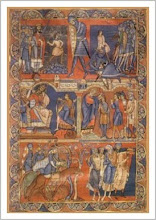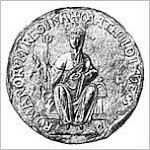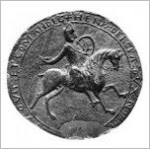• Introduction: The Seeds Are Sown
At years' end in 1119 the state of politics in Normandy and England must have looked very promising for always careful and methodical Henry I. He had been victorious in the Battle of Bremule against Louis VI of France, and he had successfully negotiated the marriage of William, his son and heir, to Isabella (or Alice) of Anjou, the daughter of Count Fulk V of Anjou, which took place in June 1119. It was a diplomatic match that secured peace between Henry and the Angevins.
• Battle of Bremule, according to Orderic Vitalis: Battle of Bremule
However, Henry's carefully crafted diplomacy was destined not to last. On 25th November 1120 William and his wife, who had adopted the name Matilda after the marriage, boarded separate ships for the journey to England. William and all his companions onboard except one, a butcher from Rouen, drowned when the White Ship struck rocks off Barfleur and sank on its maiden voyage. William's widow did not remarry and took vows at Fontevrault Abbey and eventually became its Abbess. In an ironic and fateful twist, Stephen of Blois had also made plans to travel on the doomed vessel but disembarked before it set sail. For the next 15 years the problem of the succession dominated the political machinations of Henry's reign.
He married his second wife, Adelica of Louvain, in hope of producing another male heir. Although Henry acknowledged more than 20 illegitimate children it wasn't to be and his daughter Matilda remained is only legitimate child. Henry had married her to the Emperor Henry V and when he died in 1125 the King recalled her from Germany and, escorted by Robert of Gloucester and Brian Fitzcount, she returned to Normandy and then England. In the same year, 1125, Stephen of Blois had wed Matilda, the Countess of Boulogne, adding her inheritance and the port of Wissant to his already considerable estates. Stephen, the son of Stephen, Count of Blois, and Adela, a daughter of William the Conqueror, had been sent to Henry's court after the death of his father and he had been well provided for by the King with estates in Lancaster, England, and Mortain, in north western Normandy. He had also supported Stephen's younger brother Henry of Blois, creating him Abbot of Glastonbury and Bishop of Winchester which made Henry the wealthiest clergyman in England.
Henry I's next move in 1126 was to have all the barons swear an oath of fealty to his daughter and uphold her claim to the throne should he die without a male heir. In an effort to renegotiate the deal he had struck with the Angevins once before Henry then married Matilda to the youthful Geoffrey, son of Count Fulk, who was some 11 years her junior in 1127/8. This angered the Norman barons, who were unenthusiastic at the prospect of being ruled by a woman with an Angevin husband. Apparently Matilda herself was just as reluctant as the barons and her marriage to Geoffrey was particularly stormy. However, their first son Henry duly arrived on 25th March 1133, and the barons were again required to pledge their allegiance to Matilda and her heir.
Henry's decisions and actions during these years would have far reaching and unforeseen consequences for the English realm after his death in Normandy in December 1135.
• The Ecclesiastical History of Orderic Vitalis: Henry I
• The Anglo-Saxon Chronicle: The Years 1102-1154
• Henry I, King of England and Duke of Normandy by William of Newburgh: Henry I
• Warfare between Henry I and Robert Curthose according to Wace: Warfare between Henry I and Robert Curthose
02 August 2010
Subscribe to:
Post Comments (Atom)








No comments:
Post a Comment